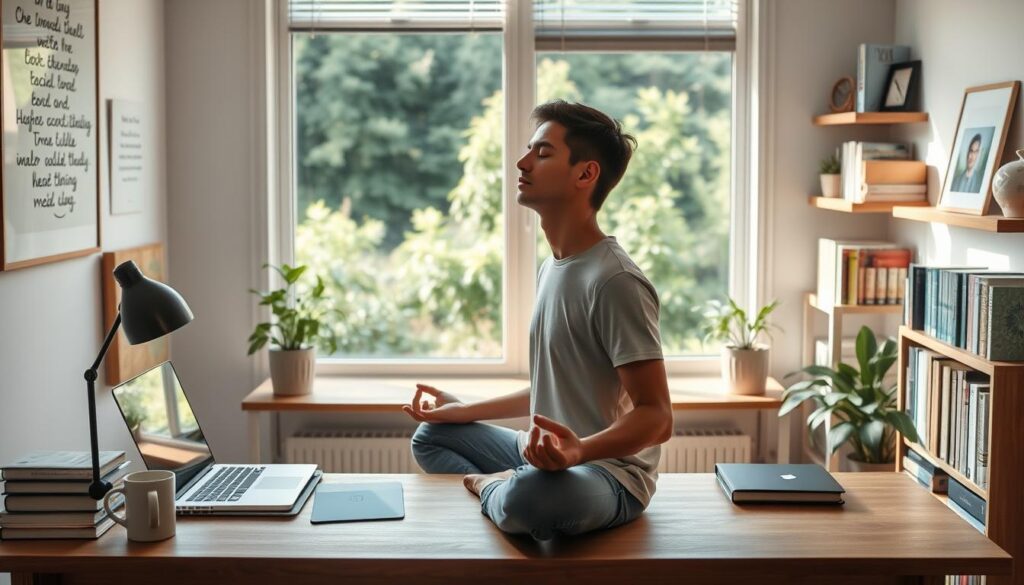Ever felt drained after a busy day but kept smiling? We’ve all been there. Emotional energy balance is more than avoiding burnout. It’s about building habits that boost your mental health every day.
This article shows how small choices can change how you handle emotions. It’s about making self-care a priority and growing strong against life’s challenges.
Key Takeaways
- Emotional energy balance is key for lasting mental health.
- Practices like mindfulness and journaling build lasting strength.
- Good physical health and food choices affect your mood.
- Healthy relationships and setting boundaries help keep emotions balanced.
- Getting help from professionals and using apps can guide you to balance.
Understanding Emotional Energy Balance
Emotional energy plays a big role in our daily lives. To find emotional harmony and keep emotional health, we must understand its power. It affects how we react to happiness, stress, and more.
What is Emotional Energy?
Emotional energy is the force behind our feelings, like excitement or calm. Think of it as a battery. When we let negativity drain it, we lose focus and strength. But, positive emotions can recharge it, helping us face challenges with clarity.
The Importance of Balance
- Prevents burnout by managing stress triggers.
- Strengthens relationships through better communication.
- Sharpens problem-solving by reducing emotional overwhelm.
Signs of Imbalance
Ignoring emotional energy can lead to:
- Persistent tiredness despite enough sleep.
- Mood shifts affecting work or social interactions.
- Physical symptoms like frequent headaches or stomachaches.
Spotting these signs early can help us make changes for better well-being. Small steps, like taking mindful pauses or journaling, can help restore balance. This protects our long-term emotional health.
The Science Behind Emotional Energy
Emotional energy is more than just a feeling. It’s based on brain chemistry. Neurotransmitters like serotonin and dopamine send messages that affect how we feel and stay energized. When these chemicals are off balance, it can make us feel drained and affect our mood.
How Emotions Affect Energy Levels
The limbic system, our emotional center, links directly to the prefrontal cortex, which handles rational thinking. This connection decides if emotions give us energy or take it away. For example, stress makes cortisol levels rise, which can slow down our thinking over time.
A 2020 Harvard study showed that positive emotions increase dopamine. This can improve focus and productivity by up to 30%.
Coping Mechanisms for Energy Fluctuations
There are science-backed ways to keep your energy stable. Try these:
- Cognitive reframing: Change negative thoughts to positive ones to avoid feeling drained (e.g., “This challenge is temporary”).
- Energy banking: Make sure to rest when you’re feeling low to recharge.
- Pattern recognition: Keep a journal to track what makes you feel low so you can avoid it.
| Strategy | Science Link | Impact |
|---|---|---|
| Cognitive reframing | Reduces amygdala activation | Stabilizes mood swings |
| Energy banking | Supports hippocampus recovery | Boosts long-term focus |
Making small changes every day, based on science, can lead to lasting energy balance. Start by noticing your emotional patterns today.
Daily Practices for Balance
Maintaining inner balance begins with small, consistent actions. Even a few minutes each day can boost your emotional strength. These practices increase awareness and help you respond wisely to life’s challenges.
Mindfulness and Meditation
Try these techniques to find your center:
- 5-Minute Guided Breathing: Sit quietly, inhaling for four counts, holding, then exhaling slowly. Repeat for five cycles.
- Body Scan Meditation: Close your eyes and mentally scan from toes to head, releasing tension in each part.
- Loving-Kindness Practice: Silently repeat phrases like, “May I be safe. May I be peaceful,” to foster self-compassion.
Journaling for Emotional Clarity
Use these prompts to track your emotional state:
- “What triggered my mood today?”
- “Name one moment of gratitude.”
- “How did my physical sensations match my emotions?”
Writing for just 5–10 minutes daily helps spot patterns and lessen overwhelm.
“The human brain cannot multitask. Focus on one breath, one word, one moment. That’s where peace begins.”
Combine these practices with mindful pauses throughout the day. Over time, these steps lead to lasting changes in stress management and inner balance.
The Role of Physical Health
Your body and mind are closely linked. To boost emotional wellness, start with your physical health. Simple diet and activity changes can increase energy, stabilize moods, and build resilience.
Nutrition and Emotional Energy
What you eat affects how you feel. Focus on foods that keep blood sugar stable and support brain health. Here are some key choices:
- Complex carbs like oats or quinoa for steady energy.
- Omega-3 foods like salmon or walnuts to reduce inflammation and improve mood.
- Colorful fruits and veggies for antioxidants to fight stress.

Exercise as a Mood Booster
Movement is more than physical—it’s a mental refresh. High-intensity workouts release endorphins, while yoga and tai chi promote calm. Aim for a mix of:
- 30 minutes of brisk walking daily to boost serotonin.
- Strength training twice a week to build stress resilience.
- Stretching to ease tension.
Taking care of your physical health is essential for emotional energy. Small, consistent choices in diet and activity lay the groundwork for well-being.
Cultivating Healthy Relationships
Healthy relationships are key for emotional resilience. They protect us from stress and give us new energy. Good connections help us bounce back from tough times. But bad ones can make us feel drained.
Let’s look at how to build strong, uplifting relationships.
“Relationships either lift you up or weigh you down. Choose wisely.” — Karina Stewart, Traditional Chinese Medicine Practitioner
Building Supportive Connections
Find people who make you grow and feel understood. Stay away from those who suck your energy. Focus on a few close friends who share your values.
Practical strategies like regular chats and listening well build trust. Relationships based on shared goals and respect are strong.
Setting Boundaries
- Use clear scripts: “I need space to recharge” instead of vague excuses.
- Practice saying “no” without guilt—your energy is finite.
- Recognize manipulative tactics like guilt-tripping or gaslighting; set firm limits.
Introverts might prefer fewer, deeper talks, while extroverts need more social interaction. Adapting to your personality helps keep relationships balanced. Healthy boundaries are essential for your emotional health, boosting emotional resilience over time.
Time Management for Emotional Wellness
Effective time management is more than just doing tasks. It’s about keeping your emotional energy safe. By matching your schedule with your natural energy highs and lows, you can feel more positive. You also keep a good balance between work, rest, and recovery. Let’s look at ways to make your calendar a tool for emotional strength.

| Traditional Scheduling | Energy-Based Scheduling |
|---|---|
| Clocks dictate tasks | Energy levels guide priorities |
| Long, uninterrupted work blocks | Short focused sessions with breaks |
| Rare rest periods | Recovery built into daily flow |
Prioritizing Tasks
- Use energy mapping: Note when you feel most focused (morning, afternoon, etc.) and assign complex tasks to those hours.
- Batch similar tasks (emails, calls) to reduce mental switching costs.
- Include “recharge” slots for hobbies or quiet time—these aren’t wasted minutes but emotional investments.
Scheduling Breaks
Ultradian rhythms show energy naturally dips every 90–120 minutes. Use this science to:
- Work in 25-minute Pomodoro sessions followed by 5-minute pauses.
- Schedule 20-minute walks or deep breathing post-meetings.
These pauses prevent burnout and boost creativity, keepingpositivityintact.
Try this template for an “ideal day”:
| Time Block | Activity Type |
|---|---|
| 8–10 AM | High-energy tasks |
| 10:30 AM | 10-minute walk |
| 3–4 PM | Creative projects |
| 4:30 PM | Review and reflect |
This model respects your body’s rhythms and fosters sustainablebalance.
Seeking Professional Help
Knowing when to ask for help is vital for your mental well-being and emotional health. Professional advice can help you tackle issues that self-care can’t solve.
When to Consult a Therapist
Spotting warning signs is the first step. Look out for:
- Persistent sadness or anxiety lasting over two weeks
- Sudden changes in sleep or appetite
- Avoiding social activities once enjoyed
- Thoughts of self-harm or hopelessness
| Therapy Type | Focus |
|---|---|
| Cognitive Behavioral Therapy (CBT) | Challenges negative thought patterns |
| Dialectical Behavior Therapy (DBT) | Builds coping skills for intense emotions |
| Somatic Therapy | Addresses emotional tension stored in the body |
Benefits of Counseling
“Therapy provides a safe space to unpack challenges without judgment,” says the American Psychological Association.
Professional help offers:
- Personalized strategies tailored to your needs
- Objective feedback to gain perspective
- Access to evidence-based techniques
Check out therapist directories like Psychology Today or Open Path Collective for affordable options. Many insurance plans cover sessions, so check your policy.
Choosing professional guidance is a proactive step for long-term emotional health. Your journey to balance needs expert support.
Tools and Resources We Recommend
Boost your emotional energy balance with these carefully selected tools. Our picks focus on practicality, ease of use, and proven impact on emotional well-being.
Apps for Emotional Tracking
Apps make it easy to monitor and manage emotional energy. Here are our top picks:
| App Name | Key Features | Best For |
|---|---|---|
| Calm | Meditation guides, sleep stories, mood tracking | Stress reduction and daily calm |
| Daylio | Quick mood logging, pattern analysis | Visual learners and daily tracking |
| Headspace | Guided sessions for focus and mindfulness | Busy professionals needing quick resets |
Books for Emotional Intelligence
- Emotional Intelligence 2.0 by Daniel Goleman – A foundational guide to recognizing and managing emotions.
- The Dialectical Behavior Therapy Workbook by Matthew McKay – Practical exercises for emotional regulation.
- Our favorite quick-reference resource: Zenjump’s “Emotional Energy Awareness” guide, which emphasizes mindful practices for daily balance.
“Recognizing how emotions influence decisions is key to sustaining emotional energy balance.”
Pair these tools with consistent practice to build lasting habits. Start small and explore what works best for your needs.
Maintaining Balance in Challenging Times
Life’s ups and downs can shake our emotional balance. Building emotional resilience means finding ways to adapt in changing times. Small, thoughtful actions can help keep us grounded when things get tough.
Coping with Stressful Situations
Quick techniques like deep breathing or grounding exercises can calm us down. Apps like Calm or Headspace offer guided sessions to help focus. In tough times, take care of yourself first, then slowly rebuild your routine.
Reaching out to friends or a counselor can also help. They offer support and new ways to cope.
Adapting to Change
Being too rigid can hold us back. Being flexible and using tools like The Resilience Factor helps us adjust. See challenges as chances to improve, not as failures.
Keeping a journal or meditating regularly helps us see patterns. This guides us to make better choices and keep moving forward.
Inner balance is a journey, not a fixed point. Acknowledge small victories and be gentle with yourself when you stumble. By sticking to adaptable practices, we build the emotional strength to handle life’s changes. It’s the journey, not perfection, that brings lasting happiness.

